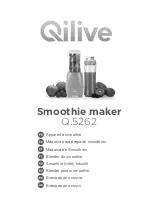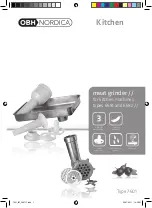
CLEANING
4
5
IT IS IMPORTANT TO READ & UNDERSTAND ALL OF THE INSTRUCTIONS
Make sure power switch is turned off. Place the unit on a clean, dry surface away from children
and pets. Plug into an undamaged, grounded electrical outlet.
1. Follow your recipe for the food that you wish to dehydrate then place the food evenly on the shelves provided. You can use
cooking spray to help prevent sticking.
DO NOT
allow food pieces to touch or overlap.
2. Carefully place shelves onto the brackets inside the unit and slowly slide them in, do not force shelves. Forcing shelves further
than necessary may cause damage to the fan guard, fan or heating assembly.
3. Slide door into place. Turn power toggle switch on and set desired temperature by turning the corresponding knob on the top
of the unit. Monitor the internal temperature and adjust as needed. Unit WILL NOT OPERATE until timer switch is set to;
“ON” for continuous running
OR
the number of hours you want the unit to run. The unit will shut off automatically
after the set time has elapsed. You must turn the timer off when using “ON” setting.
4. Fan will run continuously when in operation. (If fan does not run, turn off unit and unplug from outlet and call LEM Products
877-536-7763 for technical assistance.)
5. Periodically check for even drying or your product. If drying is uneven, use oven mitts to rotate or rearrange the shelves up or down.
6. When dehydrating is complete, use oven mitts to remove the front panel by sliding it straight up. Set it aside on a
heat-resistant surface. Slide shelves out and remove finished product.
7. Note: Moisture may collect on the bottom of the unit during operation and can be wiped out with a paper towel.
WARNING:
Unit may be hot. Avoid touching the walls and shelves with your bare hands as burns may result.
BEFORE CLEANING OR SERVICING THE DEHYDRATOR, UNPLUG UNIT FROM POWER SOURCE.
Prior to first use and after each use:
• Allow dehydrator to cool completely before cleaning.
• Remove the shelves and drip tray from the dehydrator and wash in warm soapy water.
• Wipe the door, interior and exterior of the dehydrator with a moist sponge or soft cloth.
DO NOT
use scouring pads or
abrasive cleaners. Be careful to not splash water onto the heating element or other electrical parts in the rear of the
dehydrator.
NEVER
immerse the dehydrator cabinet in water or other liquid.
• Allow dehydrator to dry completely prior to storage.
• Keep in a cool dry place.
THE THERMAL PROBE SHOULD NOT BE REMOVED. TO AVOID ELECTRICAL SHOCK THE PROBE MUST BE PROPERLY
INSTALLED AT ALL TIMES. DO NOT ATTEMPT TO REMOVE, RELOCATE OR ALTER THE PROBE IN ANY WAY.
Cuts, injuries and/or fire may result from non-compliance with all operating procedures
described within this instruction manual.
BEWARE! HANDLE CAREFULLY! SOME SURFACES MAY BECOME VERY HOT DURING USE!
Serious injury may result! DO NOT move the dehydrator while hot,
allow the appliance to cool before handling.
TO OBTAIN THE BEST RESULTS:
1. Choose high quality foods. Do not use foods with bruises or blemishes.
2. Wash food, use clean utensils and keep your area clean.
3. Pre-treat foods to prevent discoloration.
4. Always use lean meats. Remove as much fat as possible prior to dehydrating.
5. Blanch food with skins prior to dehydrating. This process will lock in color and flavor as well as soften skins of things like
grapes, cherries and plums.
6. Do not overlap foods. Air must circulate. Lay foods flat and spaced on the trays.
7. If uneven drying is noticed, rotate shelves 180˚ or rearrange up or down.
8. Check dryness every 2 hours until crisp, pliable or leathery depending on the product. Cut item in half and check internal
dryness. If food is still moist, dehydrate longer.
9. Drying times may vary depending on room temperature, relative humidity and moisture levels in the food you are drying.
Drying time is also affected by the amount of food placed on the shelves. Overloading shelves will slow drying time and
may produce poor results. Use the food drying guide on page 7 as a reference.
10. Use the food drying guide on page 7 as a reference for proper temperature. Drying foods at higher temperatures may cause
food to harden. Food may be dry on the outside but the inside may still be moist.
11. Cool food before testing for dryness.
12. Proper storage is essential to maintain the quality of the food. Food should be at room temperature prior to storing.
Vacuum sealing is ideal for keeping dried foods.
13. Choose foods that are similar size and shape for uniform drying time.
ISSUE:
Food is sticking to the trays.
RESOLUTION:
After first hour turn food over.
RESOLUTION:
Prior to putting food on trays, spray or coat trays lightly with vegetable oil.
ISSUE:
Mold is on dehydrated food.
CAUSE:
Food was not allowed to cool prior to storage.
Food was not dried completely.
Storage container was not air-tight.
Food was not uniform in size which caused uneven drying.
Food was dried at too high a temperature.
Exterior was dried and hardened, but interior was still moist.
RESOLUTION:
Test several pieces of food for dryness.
Cut food and check internal dryness.
Allow food to cool prior to storage.
Dab fat droplets from jerky with paper towels or napkins.
ISSUE:
Storage container has moisture build up.
CAUSE:
Food was not allowed to cool prior to storage.
Food was not dried completely.
RESOLUTION:
Test several pieces of food for dryness.
Cut food and check internal dryness.
Dab fat droplets from jerky with paper towels or napkins.
ISSUE:
Fruits/Vegetables are discolored or have brown spots.
CAUSE:
Food was not pretreated.
Food was dried at too high of a temperature. Food is over dry.
RESOLUTION:
Pretreat cut fruits with lemon, lime or pineapple juice and water at a 1:4 ratio.
Lemon/lime soda or a product called “Fruit Fresh” can also be used.
CAUTION
LEM Products • West Chester, OH 45011 • PH: 1-877-536-7763 • lemproducts.com
LEM Products • West Chester, OH 45011 • PH: 1-877-536-7763 • lemproducts.com






















